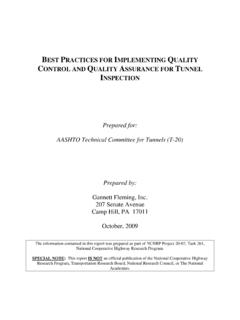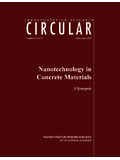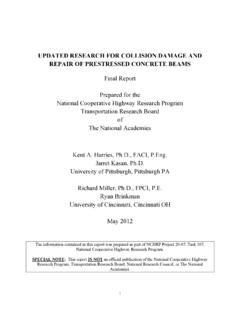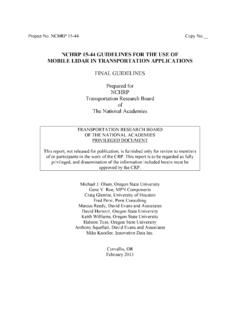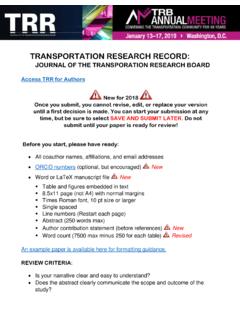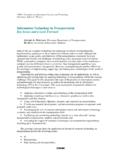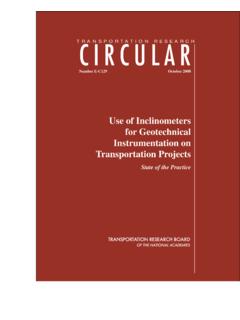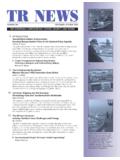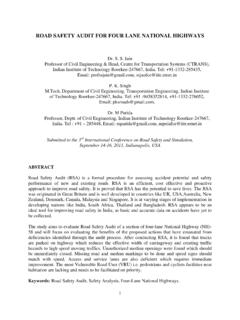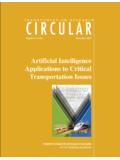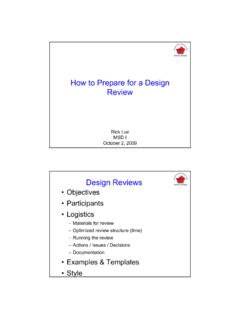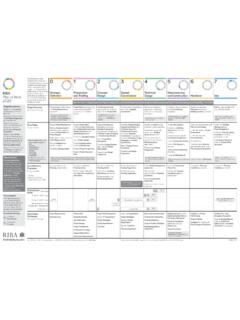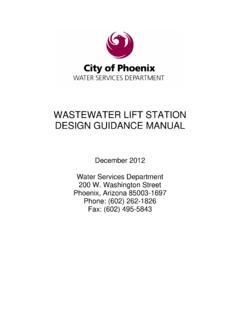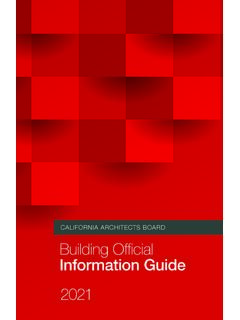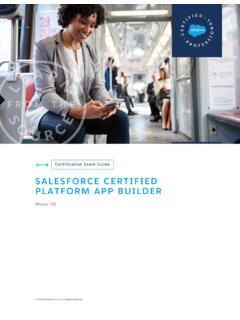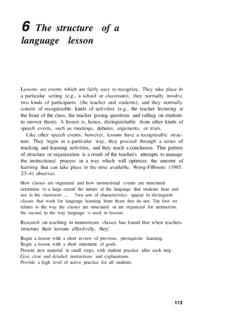Transcription of DESIGN OF PILE FOUNDATIONS
1 42 NATIONAL COOPERATIVE HIGHWAY RESEARCH PROGRAM SYNTHESIS OF HIGHWAY PRACTICE 42 DESIGN OF PILE FOUNDATIONS TRANSPORTATION RESEARCH BOARD NATIONAL RESEARCH COUNCIL TRANSPORTATION RESEARCH BOARD 1977 Officers ROBERT N. HUNTER, Chairman SCHEFFER LANG, Vice Chairman W. N. CAREY, JR., Executive Director Executive Committee HENRIK E. STAFSETH, Executive Director, American Assn. of State Highway and Transportation Officials (ex officio) WILLIAM M. COX, Federal Highway Administrator, Department of Transportation (ex officio) RICHARD S. PAGE, Urban Mass Transportation Administrator, Department of Transportation (ex officio) JOHN M. SULLIVAN, Federal Railroad Administrator, Department of Transportation (ex officio) HARVEY BROOKS, Chairman, Commission on Sociotechnical Systems, National Research Council (ex officio) MILTON PIKARSKY, Chairman of the Board, Chicago Regional Transportation Authority (ex officio, Past Chairman 1975) HAROLD L.
2 MICHAEL, School of Civil Engineering, Purdue University (ex officio, Past Chairman 1976) WARREN E. ALBERTS, Vice President (Systems Operations Services), United Airlines GEORGE H. ANDREWS, Vice President (Transportation Marketing), Sverdrup and Parcel GRANT BASTIAN, State Highway Engineer, Nevada Department of Highways KURT W. BAUER, Executive Director, Southeastern Wisconsin Regional Planning Commission MANUEL CARBALLO, Lecturer in Public Management, Harvard University L. DEBERRY, Engineer-Director, Texas State Department of Highways and Public Transportation LOUIS J. GAMBACCINI, Vice President and General Manager, Port Authority Trans-Hudson Corporation HOWARD L. GAUTHIER, Professor of Geography, Ohio State University FRANK C. HERRINGER, General Manager, San Francisco Bay Area Rapid Transit District ARTHUR J. HOLLAND, Mayor, City of Trenton, NJ. ANN R.
3 HULL, Speaker Pro Tem, Maryland House of Delegates ROBERT N. HUNTER, Chief Engineer, Missouri State Highway Department PETER G. KOLTNOW, President, Highway Users Federation for Safety and Mobility THOMAS J. LAMPHIER, President, Transportation Division, Burlington Northern, Inc. A. SCHEFFER LANG, Assistant to the President, Association of American Railroads DANIEL McFADDEN, Professor of Economics, University of California ROBERT S. MICHAEL, Director of Aviation, City and County of Denver, Colorado THOMAS D. MORELAND, Commissioner, Georgia Department of Transportation GEORGE E. PAKE, Vice President, Xerox Corp.; Manager, Xerox Palo Alto Research Center DOUGLAS N. SCHNEIDER, JR., Director, District of Columbia Department of Transportation WILLIAM K. SMITH, Vice President (Transportation), General Mills NATIONAL COOPERATIVE HIGHWAY RESEARCH PROGRAM Transportation Research Board Executive Committee Subcommittee for the NCHRP ROBERT N.
4 HUNTER, Missouri State Highway Department (Chairman) A. SCHEFFER LANG, Association of American Railroads HENRIK E. STAFSETH, Amer. Assn. of State Hwy. and Transp. Officials WILLIAM M. COX, Department of Transportation HARVEY BROOKS, National Research Council HAROLD L. MICHAEL, Purdue University W. N. CAREY, JR., Transportation Research Board Topic Panel on Pile FOUNDATIONS Project Committee SP 20-5 RAY R. BIEGE, JR., Kansas Dept. of Transportation (Chairman) VERDI ADAM, Louisiana Department of Highways JACK FREIDENRICH, New Jersey Department of Transportation DAVID GEDNEY, Federal Highway Administration EDWARD J. HEINEN, Minnesota Department of Highways BRYANT MATHER, USAE Waterways Experiment Station THOMAS H. MAY, Pennsylvania Department of Transportation THEODORE F. MORF, Consultant EDWARD A. MUELLER, Transportation Authority REX C. LEATHERS, Federal Highway Administration ROY C.
5 EDGERTON, Transportation Research Board Program Staff BERNARD E. BurLER, New York State Dept. of Transportation DAVID S. GEDNEY, Federal Highway Administration BERNARD A. GRAND, Slattery Associates DAVID HUVAL, Louisiana Department of Highways PHILIP KEENE, Consultant WENDEL T. RUFF, Mississippi State Highway Department J. W. GUINNEE, Transportation Research Board L. F. SPAINE, Transportation Research Board Consultant to Topic Panel ALEKSANDAR S. VESK, J. A. Jones Professor and Dean, School of Engineering, Duke University KRIEGER W. HENDERSON, JR., Program Director HARRY A. SMITH, Projects Engineer DAVID K. WITHEFORD, Assistant Program Director ROBERT E. SPICHER, Projects Engineer LOUIS M. MAcGREGOR, Administrative Engineer HERBERT P. ORLAND, Editor R. IAN KINGHAM, Projects Engineer PATRICIA A. PETERS, Associate Editor ROBERT J. REILLY, Projects Engineer EDYTHE T.
6 CRUMP, Assistant Editor NATIONAL COOPERATIVE HIGHWAY RESEARCH PROGRAM SYNTHESIS OF HIGHWAY PRACTICE 42 DESIGN OF PILE FOUNDATIONS ALEKSANDAR S. VESI DUKE UNIVERSITY DURHAM, NORTH CAROLINA RESEARCH SPONSORED BY THE AMERICAN ASSOCIATION OF STATE HIGHWAY AND TRANSPORTATION OFFICIALS IN COOPERATION WITH THE FEDERAL HIGHWAY ADMINISTRATION AREAS OF INTEREST: BRIDGE DESIGN CONSTRUCTION FOUNDATIONS (SOILS) RAIL TRANSPORT TRANSPORTATION RESEARCH BOARD NATIONAL RESEARCH COUNCIL WASHINGTON, 1977 NATIONAL COOPERATIVE HIGHWAY RESEARCH PROGRAM Systematic, well-designed research provides the most ef-fective approach to the solution of many problems facing highway administrators and engineers. Often, highway problems are of local interest and can best be studied by highway departments individually or in cooperation with their state universities and others. However, the accelerat-ing growth of highway transportation develops increasingly complex problems of wide interest to highway authorities.
7 These problems are best studied through a coordinated program of cooperative research. In recognition of these needs, the highway administrators of the American Association of State Highway and Trans-portation Officials initiated in 1962 an objective national highway research program employing modern scientific techniques. This program is supported on a continuing basis by funds from participating member states of the Association and it receives the full cooperation and sup-port of the Federal Highway Administration, United States Department of Transportation. The Transportation Research Board of the National Re-search Council was requested by the Association to admin-ister the research program because of the Board's recog-nized objectivity and understanding of modern research practices. The Board is uniquely suited for this purpose as: it maintains an extensive committee structure from which authorities on any highway transportation subject may be drawn; it possesses avenues of communications and cooperation with federal, state, and local governmental agencies, universities, and industry; its relationship to its parent organization, the National Academy of Sciences, a private, nonprofit institution, is an insurance of objectivity; it maintains a full-time research correlation staff of special-ists in highway transportation matters to bring the findings of research directly to those who are in a position to use them.
8 The program is developed on the basis of research needs identified by chief administrators of the highway and trans-portation departments and by committees of AASHTO. Each year, specific areas of research needs to be included in the program are proposed to the Academy and the Board by the American Association of State Highway and Trans-portation Officials. Research projects to fulfill these needs are defined by the Board, and qualified research agencies are selected from those that have submitted proposals. Ad-ministration and surveillance of research contracts are responsibilities of the Academy and its Transportation Research Board. The needs for highway research are many, and the National Cooperative Highway Research Program can make signifi-cant contributions to the solution of highway transportation problems of mutual concern to many responsible groups.
9 The program, however, is intended to complement rather than to substitute for or duplicate other highway research programs. NCHRP Synthesis 42 Project 20-5 FY '73 (Topic 5-04) ISBN 0-309-02544-3 L. C. Catalog Card No. 77-90474 Price: $ Notice The project that is the subject of this report was a part of the National Cooperative Highway Research Program conducted by the Transportation Research Board with the approval of the Governing Board of the National Research Council, acting in behalf of the National Academy of Sciences. Such approval reflects the Governing Board's judgment that the program concerned is of national impor-tance and appropriate with respect to both the purposes and re-sources of the National Research Council. The members of the technical committee selected to monitor this project and to review this report were chosen for recognized scholarly competence and with due consideration for the balance of disciplines appropriate to the project.
10 The opinions and con-clusions expressed or implied are those of the research agency that performed the research, and, while they have been accepted as appropriate by the technical committee, they are not necessarily those of the Transportation Research Board, the National Research Coun-cil, the National Academy of Sciences, or the program sponsors. Each report is reviewed and processed according to procedures established and monitored by the Report Review Committee of the National Academy of Sciences. Distribution of the report is ap-proved by the President of the Academy upon satisfactory comple-tion of the review process. The National Research Council is the principal operating agency of the National Academy of Sciences and the National Academy of Engineering, serving government and other organizations. The Transportation Research Board evolved from the 54-year-old High-way Research Board.
